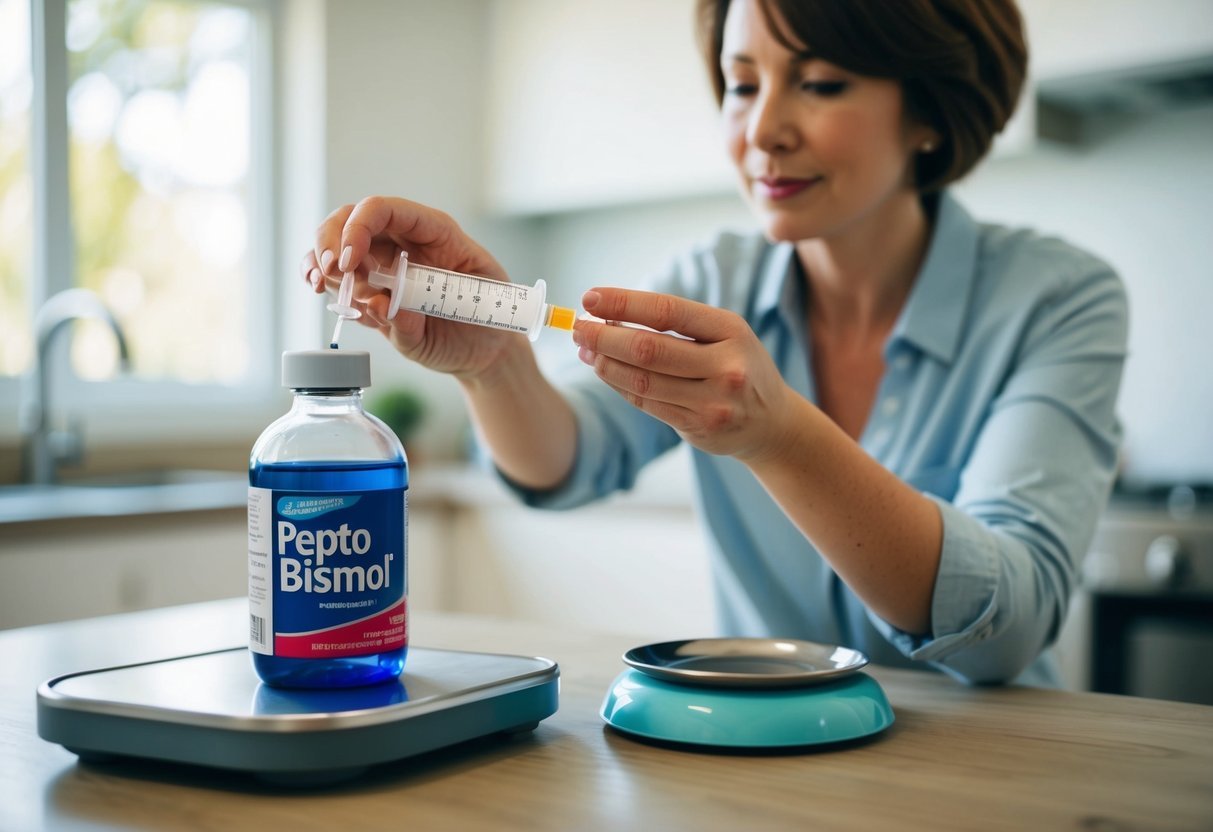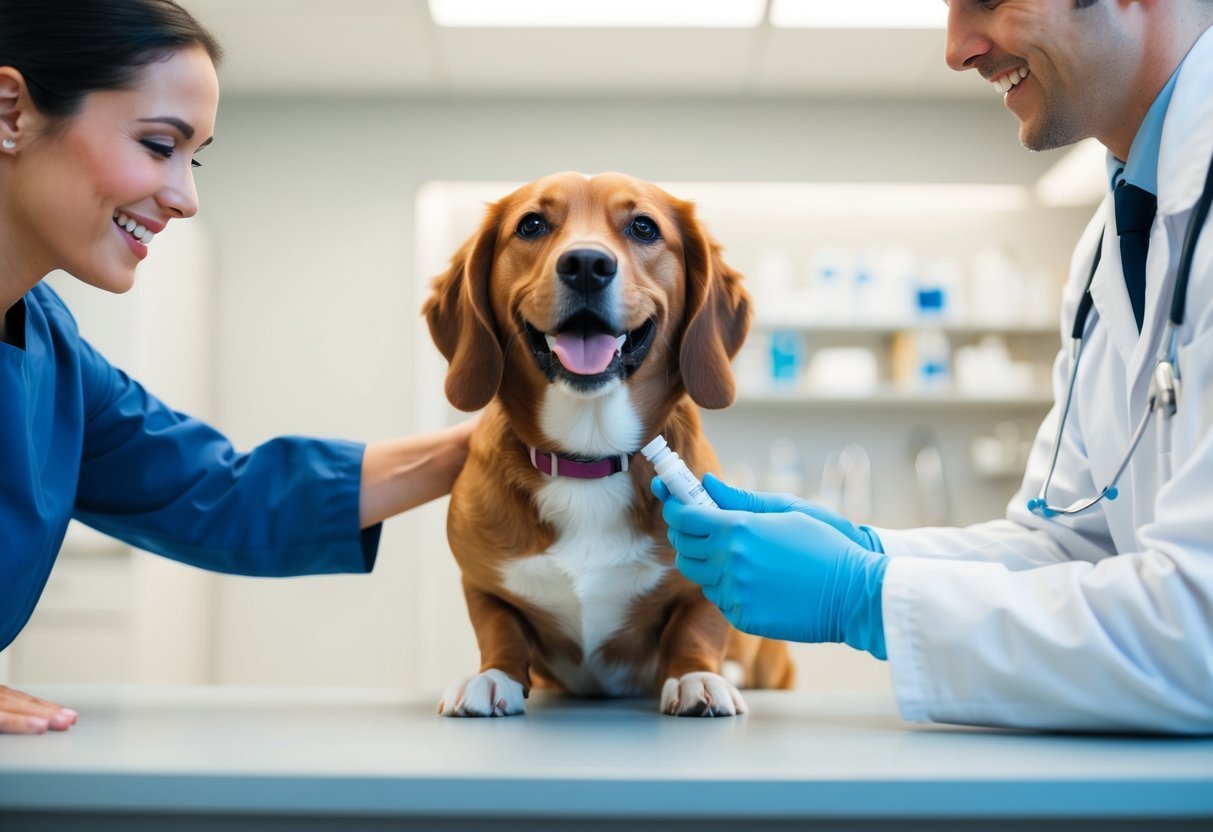When your dog isn’t feeling well, you might consider using Pepto Bismol as a quick remedy for digestive issues.
Knowing how to give your dog Pepto Bismol safely is essential for their health.
It’s important to ensure you understand the proper usage and potential risks involved.
Many pet owners wonder if over-the-counter medication like Pepto Bismol is suitable for their furry friends.
With the right tips, you can make sure your dog gets the help they need while minimizing any dangers.
Being informed is key to making the best choices for your pet’s well-being.
1) Consult Your Vet First

Before giving your dog Pepto Bismol, make sure to check with your vet.
They know your dog’s health history and can give you the best advice.
Not all dogs can take Pepto Bismol safely.
Some may have conditions or are on medications that could interact poorly with it.
Your vet will help determine if it’s suitable for your furry friend.
Dosage is another key point.
The right amount often depends on your dog’s weight and health.
Your vet can provide specific details to avoid any issues.
If your dog shows symptoms like vomiting or lethargy, call your vet right away instead of trying over-the-counter solutions.
It’s better to be safe and ensure your pet gets the care they need.
Check Dosage: Typically 0.5-1 ml per lb

When giving your dog Pepto Bismol, it’s crucial to check the dosage carefully.
A common guideline is to give between 0.5 to 1 ml per pound of your dog’s weight.
For example, if your dog weighs 20 pounds, you would give them between 10 to 20 ml of the medication.
Always measure the dose accurately using a syringe or dosing cup.
Before you start, make sure to consult your veterinarian.
They can provide personalized advice and adjust the dosage based on your dog’s specific needs.
Remember, every dog is different.
Factors like age, health, and medical history can affect how much Pepto Bismol is safe for them.
Always prioritize your dog’s safety and comfort.
3) Use Only Liquid Pepto, Avoid Tablets
When giving your dog Pepto Bismol, stick to the liquid form.
Liquid Pepto is easier for dogs to swallow and digest compared to tablets.
The smooth texture makes it a better option for pups who might have trouble with chewable options.
Chewable tablets can have ingredients that aren’t safe for dogs.
Some dogs may not even want to eat the tablets at all.
It’s best to keep things simple and safe by using the liquid version.
Most veterinarians recommend the liquid for its effectiveness and ease of administration.
Plus, it’s the form that is most commonly used for treating upset stomachs in dogs.
Always check the label and avoid any flavored or extra ingredients.
Stick to the standard liquid Pepto Bismol to keep it safe for your furry friend.
If you have any doubts or concerns, consult your vet before giving your dog any medication.
They can guide you on the right dosage and the safest way to help your dog feel better.
Monitor for Side Effects Like Constipation

When you give your dog Pepto Bismol, make sure to keep an eye on how they react.
One common side effect is constipation.
Watch for any changes in your dog’s bathroom habits.
If your dog struggles to go or shows signs of discomfort, it may be time to take action.
If you notice constipation, try to encourage your dog to drink more water.
Hydration can help keep things moving.
You can also add some canned pumpkin to their diet, as it can aid digestion.
Keep in mind that some dogs may experience darker stools after taking Pepto Bismol.
This change is usually harmless, but it’s still a good idea to monitor it, especially if the stool doesn’t return to normal.
If you see severe reactions or if constipation continues for more than a day, it’s best to consult your veterinarian.
They can provide guidance on what to do next.
Always prioritize your dog’s health and comfort when using any medication.
Understanding Pepto Bismol for Dogs
Pepto Bismol can be a helpful option for dealing with some gastrointestinal issues in dogs.
It is important to know how it works and when it is safe to use it for your furry friend.
How It Works
Pepto Bismol contains bismuth subsalicylate, which helps soothe the stomach and intestines.
It has anti-inflammatory properties that can reduce irritation.
This can be helpful if your dog has an upset stomach, mild diarrhea, or nausea.
When your dog takes Pepto Bismol, it coats the stomach lining.
This coating can help protect against irritation from acids or other digestive issues.
However, it is not a cure for more serious conditions.
Always monitor your dog for any side effects.
When It’s Safe to Use
Before giving Pepto Bismol to your dog, make sure it is safe.
It can be safe for dogs with certain conditions if used correctly.
Here are some key points to consider:
- Consult Your Vet: Always check with your veterinarian first. They can give you the best advice based on your dog’s health.
- Age and Weight: Consider your dog’s age and weight. Dosages vary based on these factors.
- Existing Health Problems: Do not use it if your dog has a history of gastrointestinal ulcers, bleeding disorders, or is pregnant.
- Watch for Reactions: If you notice any vomiting, diarrhea, or other adverse reactions, stop giving it immediately and contact your vet.
Keeping these points in mind can help ensure your dog’s safety while using Pepto Bismol.
Potential Side Effects

When giving your dog Pepto Bismol, it’s essential to be aware of possible side effects.
Understanding these reactions can help you keep your furry friend healthy and safe while using this medication.
Common Reactions
Some dogs may experience mild side effects after taking Pepto Bismol.
These can include:
- Diarrhea: While Pepto Bismol is meant to help with tummy troubles, it might cause loose stools in some dogs.
- Constipation: On the flip side, too much of the medication may lead to constipation.
- Nausea or Vomiting: Some dogs might feel queasy or even get sick after taking it.
Always monitor your dog for changes in behavior or health after giving them the medication.
If your pup shows signs of distress, such as excessive drooling or lethargy, take note.
Keeping a close eye on your dog’s reactions will help you catch any potential issues early.
When to Call the Vet
If you notice any severe or unusual reactions, make sure to consult your veterinarian.
Here are situations where a call is necessary:
- Persistent Vomiting or Diarrhea: If your dog continues to vomit or has diarrhea for more than a few hours, seek professional help.
- Signs of Allergic Reaction: Symptoms like swelling, hives, or difficulty breathing after giving Pepto Bismol should be treated as an emergency.
- Unusual Behavior: If your dog becomes excessively lethargic, disoriented, or unresponsive, don’t hesitate to reach out to your vet.
Being proactive about your dog’s health can make a big difference.
If you’re ever in doubt, it’s better to be safe and call your vet.
Frequently Asked Questions

Pepto Bismol can help with your dog’s tummy troubles, but it’s important to know how to use it safely.
Here are some common questions about giving Pepto Bismol to dogs and what to keep in mind.
How can I figure out the correct Pepto Bismol dosage for my dog?
For the correct dosage, you can generally give 0.5 to 1 ml of liquid Pepto Bismol per pound of your dog’s weight.
This means a 10-pound dog would get about 5 to 10 ml.
Always double-check with your vet to ensure it’s right for your specific dog.
Is there a safe amount of Pepto Bismol to give to a dog with an upset stomach?
Yes, there is a safe amount, but it’s important to stick to small doses.
You can give it every 6 to 8 hours for no more than 24 hours.
If your dog’s upset stomach continues after that, contact your vet for further advice.
What should I do if my dog has diarrhea?
If your dog has diarrhea, Pepto Bismol may help.
Start with the correct dosage and watch for any changes.
Make sure to keep them hydrated and monitor their condition closely.
If the diarrhea lasts more than a day, it’s best to get in touch with your vet.
Are there risks associated with giving my dog Pepto Bismol?
Yes, there are some risks.
Possible side effects include constipation and changes in stool color.
Always monitor your dog after giving the medication.
If you notice any unusual symptoms, reach out to your vet for guidance.
What’s a good way to administer Pepto-Bismol to my pup?
Using a plastic syringe without a needle works well for giving Pepto Bismol.
Place the syringe toward the back of your dog’s mouth and gently squirt it in.
This method helps ensure they swallow it and don’t spit it out.
Could some dogs have adverse reactions to Pepto Bismol?
Definitely, some dogs may react poorly to Pepto Bismol.
It’s important to watch for signs like vomiting, severe lethargy, or any unusual behavior.
If you see any of these signs, contact your vet right away.

